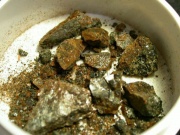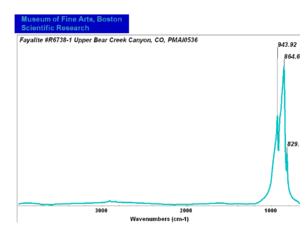Difference between revisions of "Fayalite"
Jump to navigation
Jump to search
| (3 intermediate revisions by 2 users not shown) | |||
| Line 3: | Line 3: | ||
A transparent green iron silicate mineral that occurs naturally as an iron-rich variety of [[olivine]]. Fayalite was named after Fayal, an island in the Azores. The brittle green stone is also produced synthetically as a common component in slag stringers from ancient iron working furnaces. | A transparent green iron silicate mineral that occurs naturally as an iron-rich variety of [[olivine]]. Fayalite was named after Fayal, an island in the Azores. The brittle green stone is also produced synthetically as a common component in slag stringers from ancient iron working furnaces. | ||
| + | |||
| + | [[[SliderGallery rightalign|Fayalite, Upper Bear Creek CO.PNG~FTIR (MFA)]]] | ||
== Synonyms and Related Terms == | == Synonyms and Related Terms == | ||
| Line 8: | Line 10: | ||
olivine; faialite (Port.); Fayalit (Deut.); fayaliet (Ned.) | olivine; faialite (Port.); Fayalit (Deut.); fayaliet (Ned.) | ||
| − | == | + | == Physical and Chemical Properties == |
| − | Crystal system= orthorhombic Color= green to pale yellow Fracture = conchoidal to uneven. Luster = vitreous. Streak = colorless. | + | * Crystal system = orthorhombic |
| + | * Color = green to pale yellow | ||
| + | * Fracture = conchoidal to uneven. | ||
| + | * Luster = vitreous. | ||
| + | * Streak = colorless. | ||
{| class="wikitable" | {| class="wikitable" | ||
| Line 21: | Line 27: | ||
|- | |- | ||
! scope="row"| Density | ! scope="row"| Density | ||
| − | | 4.4 | + | | 4.4 g/ml |
|- | |- | ||
! scope="row"| Refractive Index | ! scope="row"| Refractive Index | ||
| Line 27: | Line 33: | ||
|} | |} | ||
| − | == | + | ==Resources and Citations== |
| − | |||
| − | |||
| − | + | * Mineralogy Database: [http://www.webmineral.com/data/Fayalite.shtml Fayalite] | |
* David C. Scott, ''Metallography and Microstructure of Ancient and Historic Metals'', The Getty Conservation Institute, Los Angeles, 1991 | * David C. Scott, ''Metallography and Microstructure of Ancient and Historic Metals'', The Getty Conservation Institute, Los Angeles, 1991 | ||
| Line 39: | Line 43: | ||
* Thomas Gregory, ''The Condensed Chemical Dictionary'', Reinhold Publishing, New York, 3rd ed., 1942 | * Thomas Gregory, ''The Condensed Chemical Dictionary'', Reinhold Publishing, New York, 3rd ed., 1942 | ||
| − | * ''Encyclopedia Britannica'', http://www.britannica.com Comment: "fayalite." | + | * ''Encyclopedia Britannica'', http://www.britannica.com Comment: "fayalite." Accessed 12 Nov. 2004 |
| − | * Wikipedia | + | * Wikipedia: http://en.wikipedia.org/wiki/Fayalite (Accessed Sept. 7, 2005) |
[[Category:Materials database]] | [[Category:Materials database]] | ||
Latest revision as of 12:46, 24 July 2022
Description
A transparent green iron silicate mineral that occurs naturally as an iron-rich variety of Olivine. Fayalite was named after Fayal, an island in the Azores. The brittle green stone is also produced synthetically as a common component in slag stringers from ancient iron working furnaces.
Synonyms and Related Terms
olivine; faialite (Port.); Fayalit (Deut.); fayaliet (Ned.)
Physical and Chemical Properties
- Crystal system = orthorhombic
- Color = green to pale yellow
- Fracture = conchoidal to uneven.
- Luster = vitreous.
- Streak = colorless.
| Composition | Fe2SiO4 |
|---|---|
| Mohs Hardness | 6.5 - 7.0 |
| Density | 4.4 g/ml |
| Refractive Index | 1.83; 1.87; 1.88 |
Resources and Citations
- Mineralogy Database: Fayalite
- David C. Scott, Metallography and Microstructure of Ancient and Historic Metals, The Getty Conservation Institute, Los Angeles, 1991
- C.W.Chesterman, K.E.Lowe, Audubon Society Field Guide to North American Rocks and Minerals, Alfred A. Knopf, New York, 1979
- Thomas Gregory, The Condensed Chemical Dictionary, Reinhold Publishing, New York, 3rd ed., 1942
- Encyclopedia Britannica, http://www.britannica.com Comment: "fayalite." Accessed 12 Nov. 2004
- Wikipedia: http://en.wikipedia.org/wiki/Fayalite (Accessed Sept. 7, 2005)

